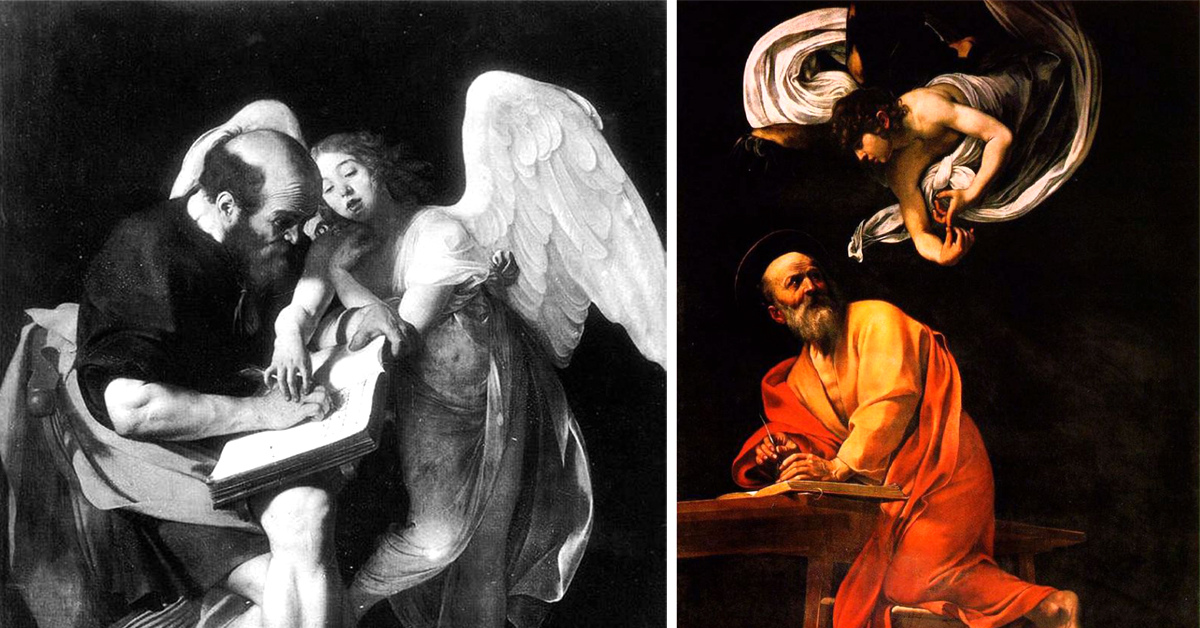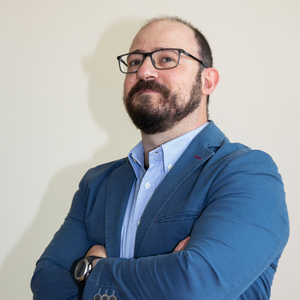We have reached the third episode of the cycle "Unveiled images, between science and history", an in-depth study dedicated to "pentimento", that is, an ongoing intervention by the artist who reconfigures the iconography, composition or some detail , with a particular focus on the period from the Renaissance to the Napoleonic era.
.jpg?width=800&name=Immagini_svelate_storia_arte_scienza_immagini_svelate_Caravaggio_San_Matteo_angelo_filosofia_UniSR%20(1).jpg)
Saint Matthew and the Angel
In the previous episode we saw, with Michelangelo's Last Judgment, how the veiling/unveiling theme intertwines theological questions with questions concerning decorum. Along this line, we can propose here some considerations regarding the first version of Caravaggio's St. Matthew and the Angel, commissioned for the Contarelli Chapel in San Luigi dei Francesi in Rome (1602) and then rejected by the client themselves. The painting was subsequently purchased by the Marquis Vincenzo Giustiniani, to finally reach, through his heirs, the Kaiser Friedrich Museum in Berlin where it was destroyed under the bombings in 1945.
.jpg?width=800&name=Immagini_svelate_storia_arte_scienza_immagini_svelate_Caravaggio_San_Matteo_angelo_filosofia_UniSR%20(2).jpg)
Michelangelo Merisi known as Caravaggio, Contarelli Chapel, San Luigi dei Francesi, Rome, overall view. Photo credit: official site of the Church of San Luigi dei Francesi https://saintlouis-rome.net/horaires-visite-opening-hours/caravage/
A rejection for theological reasons
The reason for the rejection, essentially attributed to the lack of decorum of the figure of the Saint, depicted as a rough semi-literate populace, with bare, crossed legs, was already conveyed in the seventeenth century by Giovanni Baglione and Giovanni Pietro Bellori. However, critics have long since re-dimensioned the malevolent judgment expressed by Baglione, as it was due to personal contrasts with the painter, and that expressed by Bellori, because it was conditioned by a "classicist" vision of painting far from the "naturalist" one proposed by Lombard artist.
The real reason for the refusal of Caravaggio's painting would in fact be attributable not to issues related to decorum but to issues of a higher and more subtle theological profile, in particular the delicate theme of divine inspiration in Sacred Scriptures.
.jpg?width=800&name=Immagini_svelate_storia_arte_scienza_immagini_svelate_Caravaggio_San_Matteo_angelo_filosofia_UniSR%20(3).jpg)
Caravaggio, St. Matthew and the Angel, a work that was destroyed, formerly Berlin, Kaiser Friedrich Museum, first version rejected by the client.
To differentiate the first version from the second (the one currently in the Contarelli Chapel) is the attitude of the two protagonists of the episode: the Saint and the angel. In the rejected painting, the angel materially guides the evangelist's hand in writing the Gospel, while in the accepted version the angel limits himself to dictating the Gospel message to Matthew by calculating and communicating the events with his fingers.
.jpg?width=800&name=Immagini_svelate_storia_arte_scienza_immagini_svelate_Caravaggio_San_Matteo_angelo_filosofia_UniSR%20(5).jpg)
Caravaggio, St. Matthew and the Angel, Contarelli Chapel, St. Louis of the French, Rome, second version.
The first painting, already in Berlin, would be the visual application, and in all literal senses, of the doctrine of "verbal dictation", in which the Holy Spirit, through the angel, really "moves the pen" of the writer while the second, always on site in the Contarelli Chapel, would be the most elusive representation of the autonomous participation of the Evangelist in the editing of the sacred text.
It is clear then, already from this brief exposition, how the question involves sophisticated theological disquisitions not only on the intellectual authority of the Evangelist but also on the institutional authority of the Church itself, as the depositary and official spokesperson of the evangelical doctrine.
.jpg?width=800&name=Immagini_svelate_storia_arte_scienza_immagini_svelate_Caravaggio_San_Matteo_angelo_filosofia_UniSR%20(4).jpg)
Caravaggio, San Matteo and the angel; comparison between the first and second version.
The attitude of Matthew in the second version, shown inspired and obedient to the dictates of the divine messenger, in fact exhibits an attentive and aware attitude of his own evangelizing mission, relating to the angel in a present and active way, that is, in a way quite distant from automatism perceived as unconscious of the rejected painting.
The UniSR Master's Degree Course in Theory and History of Arts and Image offers an unprecedented training path in the national panorama, based on the intertwining of traditional knowledge of art history with theoretical knowledge and critical tools of the philosophical and aesthetic areas. Find out more

In conclusion, it can be emphasized that behind apparent stylistic issues essentially linked to the principle of decorum, broad and profound problems of a conceptual nature can also be concealed. Problems that, in the case of religious-themed art, pose pivotal issues of doctrine (in this case Catholic), such as freedom and grace. Topics therefore to be conveyed and disseminated, even in the artistic field, with due caution and circumspection.
In this sense, it was not enough for Caravaggio to make some changes to his first composition but he had to completely reset it by painting a new painting with the intent, desired by the clients, to avoid possible ambiguity of reading and interpretation by the faithful visitors of the Contarelli Chapel.
.jpg?width=800&name=Immagini_svelate_storia_arte_scienza_immagini_svelate_Caravaggio_San_Matteo_angelo_filosofia_UniSR%20(6).jpg)
The facade of the Church of San Luigi dei Francesi, Rome. Photo credit: https://eglisesfrancaisesarome.it/it/san-luigi-dei-francesi/
References
- Hass, Caravaggio’s Calling of St. Matthew reconsidered, in “Journal of the Warburg and Courtauld Institutes”, LI, 1988, pp. 245-250.
- G. De Marchi, Muziano: il San Matteo Contarelli e altro, a cura di C. Ammannato, Campisano Editore, Pisa 2016.


.jpg?width=800&name=Immagini_svelate_storia_arte_scienza_immagini_svelate_Caravaggio_San_Matteo_angelo_filosofia_UniSR%20(1).jpg)
.jpg?width=800&name=Immagini_svelate_storia_arte_scienza_immagini_svelate_Caravaggio_San_Matteo_angelo_filosofia_UniSR%20(2).jpg)
.jpg?width=800&name=Immagini_svelate_storia_arte_scienza_immagini_svelate_Caravaggio_San_Matteo_angelo_filosofia_UniSR%20(3).jpg)
.jpg?width=800&name=Immagini_svelate_storia_arte_scienza_immagini_svelate_Caravaggio_San_Matteo_angelo_filosofia_UniSR%20(5).jpg)
.jpg?width=800&name=Immagini_svelate_storia_arte_scienza_immagini_svelate_Caravaggio_San_Matteo_angelo_filosofia_UniSR%20(4).jpg)

.jpg?width=800&name=Immagini_svelate_storia_arte_scienza_immagini_svelate_Caravaggio_San_Matteo_angelo_filosofia_UniSR%20(6).jpg)